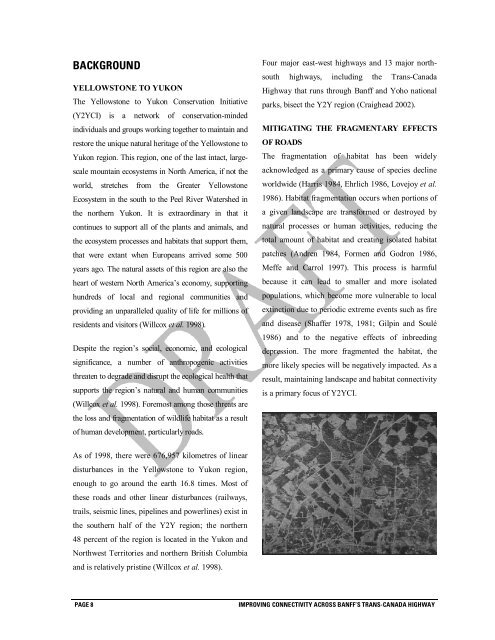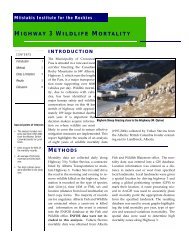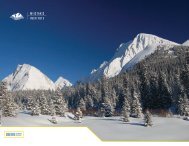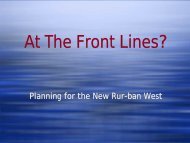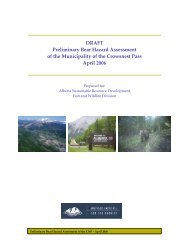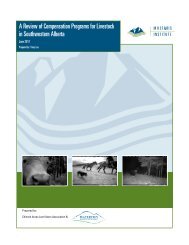A GIS based approach to restoring connectivity across Banff's Trans ...
A GIS based approach to restoring connectivity across Banff's Trans ...
A GIS based approach to restoring connectivity across Banff's Trans ...
You also want an ePaper? Increase the reach of your titles
YUMPU automatically turns print PDFs into web optimized ePapers that Google loves.
BACKGROUND<br />
YELLOWSTONE TO YUKON<br />
The Yellows<strong>to</strong>ne <strong>to</strong> Yukon Conservation Initiative<br />
(Y2YCI) is a network of conservation-minded<br />
individuals and groups working <strong>to</strong>gether <strong>to</strong> maintain and<br />
res<strong>to</strong>re the unique natural heritage of the Yellows<strong>to</strong>ne <strong>to</strong><br />
Yukon region. This region, one of the last intact, largescale<br />
mountain ecosystems in North America, if not the<br />
world, stretches from the Greater Yellows<strong>to</strong>ne<br />
Ecosystem in the south <strong>to</strong> the Peel River Watershed in<br />
the northern Yukon. It is extraordinary in that it<br />
continues <strong>to</strong> support all of the plants and animals, and<br />
the ecosystem processes and habitats that support them,<br />
that were extant when Europeans arrived some 500<br />
years ago. The natural assets of this region are also the<br />
heart of western North America’s economy, supporting<br />
hundreds of local and regional communities and<br />
providing an unparalleled quality of life for millions of<br />
residents and visi<strong>to</strong>rs (Willcox et al. 1998).<br />
Despite the region’s social, economic, and ecological<br />
significance, a number of anthropogenic activities<br />
threaten <strong>to</strong> degrade and disrupt the ecological health that<br />
supports the region’s natural and human communities<br />
(Willcox et al. 1998). Foremost among those threats are<br />
the loss and fragmentation of wildlife habitat as a result<br />
of human development, particularly roads.<br />
Four major east-west highways and 13 major northsouth<br />
highways, including the <strong>Trans</strong>-Canada<br />
Highway that runs through Banff and Yoho national<br />
parks, bisect the Y2Y region (Craighead 2002).<br />
MITIGATING THE FRAGMENTARY EFFECTS<br />
OF ROADS<br />
The fragmentation of habitat has been widely<br />
acknowledged as a primary cause of species decline<br />
worldwide (Harris 1984, Ehrlich 1986, Lovejoy et al.<br />
1986). Habitat fragmentation occurs when portions of<br />
a given landscape are transformed or destroyed by<br />
natural processes or human activities, reducing the<br />
<strong>to</strong>tal amount of habitat and creating isolated habitat<br />
patches (Andren 1984, Formen and Godron 1986,<br />
Meffe and Carrol 1997). This process is harmful<br />
because it can lead <strong>to</strong> smaller and more isolated<br />
populations, which become more vulnerable <strong>to</strong> local<br />
extinction due <strong>to</strong> periodic extreme events such as fire<br />
and disease (Shaffer 1978, 1981; Gilpin and Soulé<br />
1986) and <strong>to</strong> the negative effects of inbreeding<br />
depression. The more fragmented the habitat, the<br />
more likely species will be negatively impacted. As a<br />
result, maintaining landscape and habitat <strong>connectivity</strong><br />
is a primary focus of Y2YCI.<br />
As of 1998, there were 676,957 kilometres of linear<br />
disturbances in the Yellows<strong>to</strong>ne <strong>to</strong> Yukon region,<br />
enough <strong>to</strong> go around the earth 16.8 times. Most of<br />
these roads and other linear disturbances (railways,<br />
trails, seismic lines, pipelines and powerlines) exist in<br />
the southern half of the Y2Y region; the northern<br />
48 percent of the region is located in the Yukon and<br />
Northwest Terri<strong>to</strong>ries and northern British Columbia<br />
and is relatively pristine (Willcox et al. 1998).<br />
PAGE 8<br />
IMPROVING CONNECTIVITY ACROSS BANFF’S TRANS-CANADA HIGHWAY


